Drug Catalog - Product Detail
DESOGESTREL/ETHINYL ESTRADIOL TB 0.15/0.02/0.01MG 3X28
| NDC | Mfr | Size | Str | Form |
|---|---|---|---|---|
| 00378-7296-53 | XIROMED | 28 | 0.15-0.02/0.01MG (21/5) | TABLET |
PACKAGE FILES
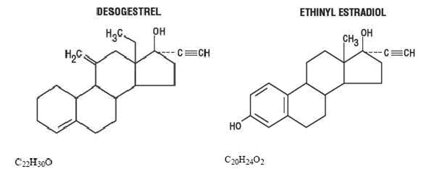
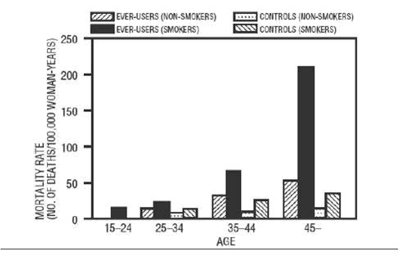


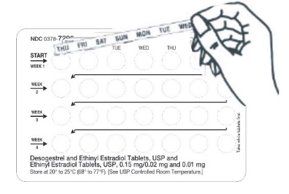
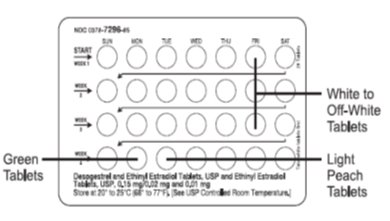
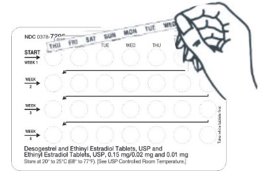
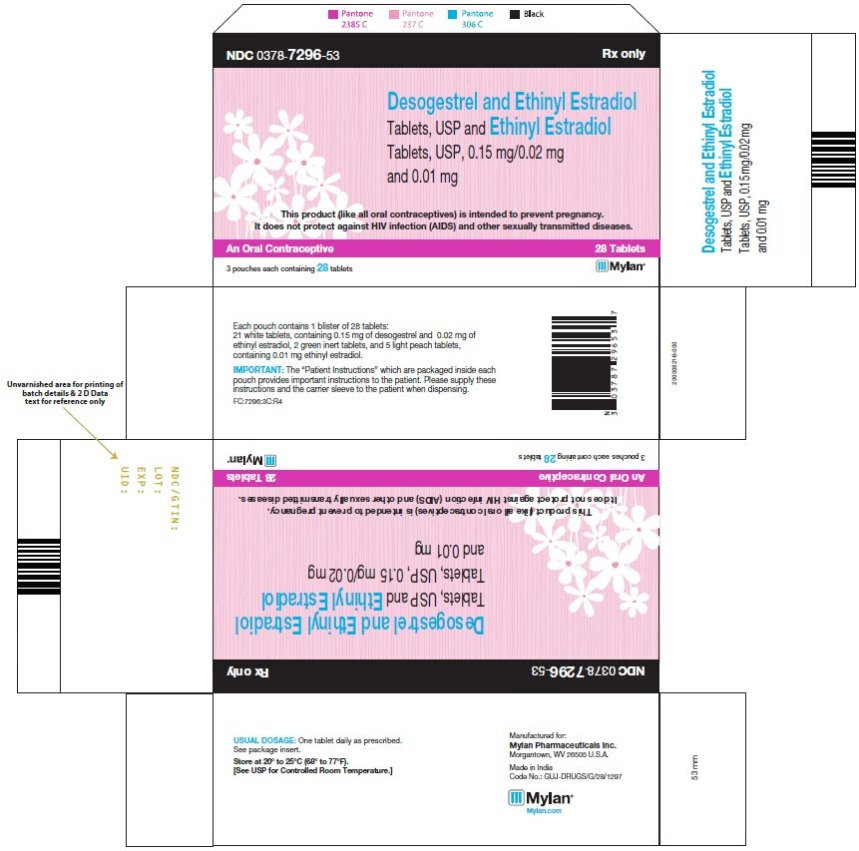
Generic Name
DESOGESTREL AND ETHINYL ESTRADIOL AND ETHINYL ESTRADIOL
Substance Name
Product Type
HUMAN PRESCRIPTION DRUG
Route
Application Number
ANDA202296
Description
DESCRIPTION Desogestrel and Ethinyl Estradiol Tablets, USP and Ethinyl Estradiol Tablets, USP provide an oral contraceptive regimen of 21 white to off-white round tablets each containing 0.15 mg desogestrel (13-ethyl-11- methylene-18,19-dinor-17 alpha-pregn- 4-en- 20-yn-17-ol), 0.02 mg ethinyl estradiol (19-nor-17 alpha-pregna-1,3,5 (10)-trien-20-yne-3,17-diol), and inactive ingredients which include anhydrous lactose, colloidal silicon dioxide, polyvinyl pyrrolidone, potato starch, stearic acid, and vitamin E, followed by 2 inert green round tablets with the following inactive ingredients: FD&C Blue No. 1 Aluminum Lake, ferric oxide yellow, lactose monohydrate, magnesium stearate and polacrilin potassium. Desogestrel and Ethinyl Estradiol Tablets, USP and Ethinyl Estradiol Tablets, USP, 0.15 mg/0.02 mg and 0.01 mg also contain 5 light peach round tablets containing 0.01 mg ethinyl estradiol (19-nor-17 alpha-pregna-1,3,5 (10)-trien-20- yne-3,17-diol) and inactive ingredients which include anhydrous lactose, dl -alpha-tocopherol, FD&C Y ellow No. 6 Aluminum Lake, lactose monohydrate, magnesium stearate, microcrystalline cellulose, polacrilin potassium and povidone K-25. The molecular weights for desogestrel and ethinyl estradiol are 310.48 and 296.40 respectively. The structural formulas are as follows: Desogestrel and ethinyl estradiol tablets meet USP dissolution test 2 Desogestrel and Ethinyl Estradiol Structural Formulas
How Supplied
HOW SUPPLIED Desogestrel and Ethinyl Estradiol Tablets, USP and Ethinyl Estradiol Tablets, USP, 0.15 mg/0.02 mg and 0.01 mg contain 21 round white to off-white tablets, 2 round green tablets and 5 round light peach tablets in a blister pack. Each round white to off-white tablet (debossed with “232” on one side and other side plain) contains 0.15 mg desogestrel and 0.02 mg ethinyl estradiol. Each round green tablet (debossed with “294” on one side and other side plain) contains inert ingredients. Each round light peach tablet (debossed with “233” on one side and other side plain) contains 0.01 mg ethinyl estradiol. Cartons of 3 NDC 0378-7296-53 Cartons of 6 NDC 0378-7296-56 Store at 20° to 25°C (68° to 77°F) [See USP Controlled Room Temperature]. Rx only
Indications & Usage
INDICATIONS AND USAGE Desogestrel and ethinyl estradiol tablets and ethinyl estradiol tablets are indicated for the prevention of pregnancy in women who elect to use this product as a method of contraception. Oral contraceptives are highly effective. Table II lists the typical accidental pregnancy rates for users of combination oral contraceptives and other methods of contraception. The efficacy of these contraceptive methods, except sterilization, depends upon the reliability with which they are used. Correct and consistent use of these methods can result in lower failure rates. TABLE II: PERCENTAGE OF WOMEN EXPERIENCING AN UNINTENDED PREGNANCY DURING THE FIRST YEAR OF TYPICAL USE AND THE FIRST YEAR OF PERFECT USE OF CONTRACEPTION AND THE PERCENTAGE CONTINUING USE AT THE END OF THE FIRST YEAR, UNITED STATES. Adapted from Hatcher et al., 1998, ref # 1. % of Women Experiencing an Unintended Pregnancy within the First Year of Use % of Women Continuing Use at One Year Among couples attempting to avoid pregnancy, the percentage who continue to use a method for one year. (4) Method (1) Typical Use Among typical couples who initiate use of a method (not necessarily for the first time), the percentage who experience an accidental pregnancy during the first year if they do not stop use for any other reason. (2) Perfect Use Among couples who initiate use of a method (not necessarily for the first time) and who use it perfectly (both consistently and correctly), the percentage who experience an accidental pregnancy during the first year if they do not stop use for any other reason. (3) Chance The percents becoming pregnant in columns (2) and (3) are based on data from populations where contraception is not used and from women who cease using contraception in order to become pregnant. Among such populations, about 89% become pregnant within one year. This estimate was lowered slightly (to 85%) to represent the percent who would become pregnant within one year among women now relying on reversible methods of contraception if they abandoned contraception altogether. 85 85 Spermicides Foams, creams, gels, vaginal suppositories, and vaginal film. 26 6 40 Periodic abstinence 25 63 Calendar 9 Ovulation Method 3 Sympto-Thermal Cervical mucus (ovulation) method supplemented by calendar in the pre-ovulatory and basal body temperature in the post-ovulatory phases. 2 Post-Ovulation 1 Withdrawal 19 4 Cap With spermicidal cream or jelly. Parous Women 40 26 42 Nulliparous Women 20 9 56 Sponge Parous Women 40 20 42 Nulliparous Women 20 9 56 Diaphragm 20 6 56 Condom Without spermicides. Female (Reality) 21 5 56 Male 14 3 61 Pill 5 71 Progestin Only 0.5 Combined 0.1 IUD Progesterone T 2.0 1.5 81 Copper T 380A 0.8 0.6 78 LNg 20 0.1 0.1 81 Depo-Provera 0.3 0.3 70 Norplant and Norplant-2 0.05 0.05 88 Female sterilization 0.5 0.5 100 Male sterilization 0.15 0.10 100
Dosage and Administration
DOSAGE AND ADMINISTRATION To achieve maximum contraceptive effectiveness, maximum contraceptive effectiveness, desogestrel and ethinyl estradiol tablets and ethinyl estradiol tablets must be taken exactly as directed and at intervals not exceeding 24 hours. Desogestrel and ethinyl estradiol tablets and ethinyl estradiol tablets may be initiated using either a Sunday start or a Day 1 start. NOTE: Each blister is preprinted with the days of the week, starting with Sunday, to facilitate a Sunday start regimen. Six different "day label strips" are provided with each blister in order to accommodate a Day 1 start regimen. In this case, the patient should place the self-adhesive "day label strip" that corresponds to her starting day over the preprinted days. IMPORTANT: The possibility of ovulation and conception prior to initiation of use of desogestrel and ethinyl estradiol tablets and ethinyl estradiol tablets should be considered. The use of desogestrel and ethinyl estradiol tablets and ethinyl estradiol tablets for contraception may be initiated 4 weeks postpartum in women who elect not to breast-feed. When the tablets are administered during the postpartum period, the increased risk of thromboembolic disease associated with the postpartum period must be considered (see CONTRAINDICATIONS and WARNINGS concerning thromboembolic disease. See also PRECAUTIONS for Nursing mothers). If the patient starts on desogestrel and ethinyl estradiol tablets and ethinyl estradiol tablets postpartum, and has not yet had a period, she should be instructed to use another method of contraception until a white to off-white tablet has been taken daily for 7 days. SUNDAY START When initiating a Sunday start regimen, another method of contraception should be used until after the first 7 consecutive days of administration. Using a Sunday start, tablets are taken daily without interruption as follows: The first white to off-white tablet should be taken on the first Sunday after menstruation begins (if menstruation begins on Sunday, the first white to off-white tablet is taken on that day). One white to off-white tablet is taken daily for 21 days, followed by 1 green (inert) tablet daily for 2 days and 1 light peach (active) tablet daily for 5 days. For all subsequent cycles, the patient then begins a new 28-tablet regimen on the next day (Sunday) after taking the last light peach tablet. [If switching from a Sunday start oral contraceptive, the first desogestrel and ethinyl estradiol tablets and ethinyl estradiol tablets should be taken on the second Sunday after the last tablet of a 21 day regimen or should be taken on the first Sunday after the last inactive tablet of a 28 day regimen.] If a patient misses 1 white to off-white tablet, she should take the missed tablet as soon as she remembers. If the patient misses 2 consecutive white to off-white tablets in Week 1 or Week 2, the patient should take 2 tablets the day she remembers and 2 tablets the next day; thereafter, the patient should resume taking 1 tablet daily until she finishes the cycle pack. The patient should be instructed to use a back-up method of birth control if she has intercourse in the 7 days after missing pills. If the patient misses 2 consecutive white to off-white tablets in the third week or misses 3 or more white to off-white tablets in a row at any time during the cycle, the patient should keep taking 1 white to off-white tablet daily until the next Sunday. On Sunday the patient should throw out the rest of that cycle pack and start a new cycle pack that same day. The patient should be instructed to use a back-up method of birth control if she has intercourse in the 7 days after missing pills. DAY 1 START Counting the first day of menstruation as "Day 1", tablets are taken without interruption as follows: One white to off-white tablet daily for 21 days, one green (inert) tablet daily for 2 days followed by 1 light peach (ethinyl estradiol) tablet daily for 5 days. For all subsequent cycles, the patient then begins a new 28-tablet regimen on the next day after taking the last light peach tablet. [If switching directly from another oral contraceptive, the first white to off-white tablet should be taken on the first day of menstruation which begins after the last ACTIVE tablet of the previous product.] If a patient misses 1 white to off-white tablet, she should take the missed tablet as soon as she remembers. If the patient misses 2 consecutive white to off-white tablets in Week 1 or Week 2, the patient should take 2 tablets the day she remembers and 2 tablets the next day; thereafter, the patient should resume taking 1 tablet daily until she finishes the cycle pack. The patient should be instructed to use a back-up method of birth control if she has intercourse in the 7 days after missing pills. If the patient misses 2 consecutive white tablets in the third week or if the patient misses 3 or more white to off-white tablets in a row at any time during the cycle, the patient should throw out the rest of that cycle pack and start a new cycle pack that same day. The patient should be instructed to use a back-up method of birth control if she has intercourse in the 7 days after missing pills. ALL ORAL CONTRACEPTIVES Breakthrough bleeding, spotting, and amenorrhea are frequent reasons for patients discontinuing oral contraceptives. In breakthrough bleeding, as in all cases of irregular bleeding from the vagina, non-functional causes should be borne in mind. In undiagnosed persistent or recurrent abnormal bleeding from the vagina, adequate diagnostic measures are indicated to rule out pregnancy or malignancy. If both pregnancy and pathology have been excluded, time or a change to another preparation may solve the problem. Changing to an oral contraceptive with a higher estrogen content, while potentially useful in minimizing menstrual irregularity, should be done only if necessary since this may increase the risk of thromboembolic disease. Use of oral contraceptives in the event of a missed menstrual period: 1. If the patient has not adhered to the prescribed schedule, the possibility of pregnancy should be considered at the time of the first missed period and oral contraceptive use should be discontinued until pregnancy is ruled out. If the patient has adhered to the prescribed regimen and misses two consecutive periods, pregnancy should be ruled out before continuing oral contraceptive use.
